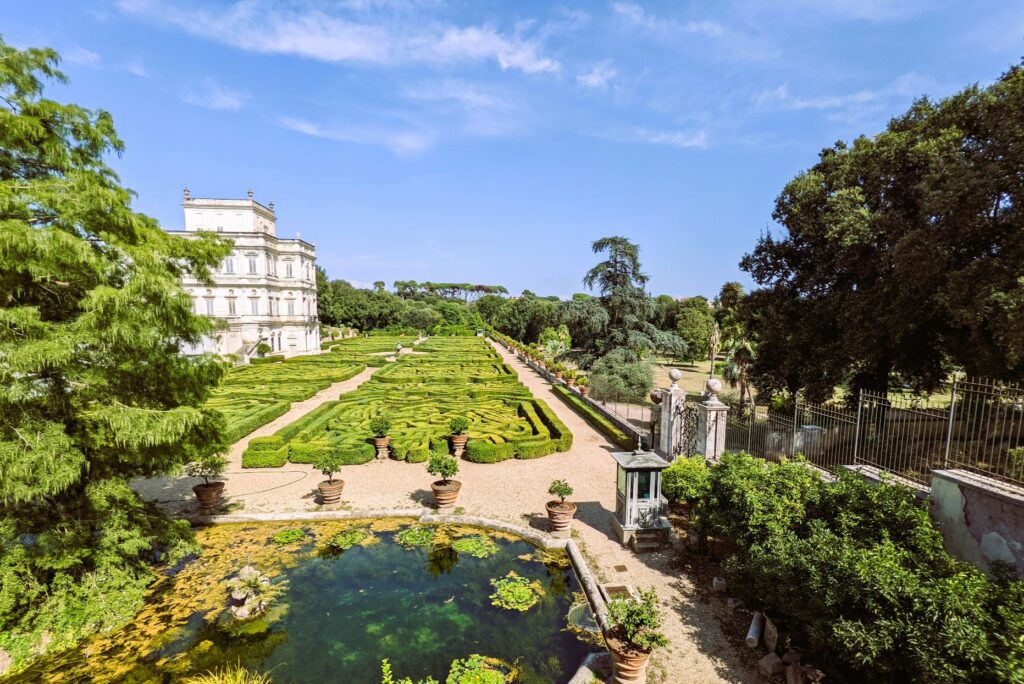
Rome’s Largest Park – A Haven for Locals
Villa Borghese is the most famous park in Rome. Anyone who has ever visited Rome has probably not only walked portions of the central park but also likely visited one of the many museums that reside in the park. While we don’t disagree that Villa Borghese is the most beautiful and fun to visit when we’re in Rome, we were quite surprised on our last visit to discover Villa Doria Pamphili Park. Not only is the park larger than Borghese, but it’s also very central, and in the heart of the summer and tourist season, we pretty much had the entire park to ourselves.
Mostly used by locals and virtually unknown to most tourists, Villa Doria Pamphili Park is a wonderful place to escape the medieval cobblestone narrow streets filled with droves of tourists and escape into incredibly wide-open, seemingly endless fields that instantly feel miles away from the city.


Villa Doria Pamphili’s Royal History
The history of the park is vast and storied. Pamfilio Pamphili purchased a remote villa in 1630 as a country house outside of the city. He then proceeded to start buying up surrounding vineyards, which ultimately amounted to a huge amount of land surrounding the villa. The property stayed in the Pamphili family for over a hundred years, before Girolamo Pamphili died in 1760 without a male heir, and disputes broke out among the possible heirs moving forward. Ultimately, the dispute was settled in 1763 by Pope Clement XIII Rezzonico, who granted Prince Giovanni Andrea IV Doria the right to take the surname, the arms, and the vast properties of the Pamphili. The Prince was awarded the properties because of the marriage between Giovanni Andrea III Doria and Anna Pamphili. Since then, the villa has been known as the Villa Doria Pamphili.
Modern Day Escape For Romans
Surprisingly absent from Lonely Planet’s top ten list for “Best Parks In Rome,” Villa Doria Pamphili Park is a wonderful place for Romans to get away from the madness for a few hours and enjoy huge spaces to run, play sports, picnic, or just sit in a giant open field without hearing a single car horn or tourist.
We loved spending many afternoons at Villa Doria Pamphili. The park was an easy and serene place for us to sneak away from Rome’s frenetic pace, a small escape which refreshed and energized us to get back into the world of Roman lunacy that we love so much.


Best Way to Access the Park
There are multiple ways to access the park, but we recommend taking the walk up Gianicolo Hill (Janiculum) from Trastevere, past Fontana dell’Acqua Paola, which provides amazing views of the city, and then enter the park from the most northeastern access. The first thing you will pass upon entering the park from this entrance is the Arch of the Four Winds (Arco dei Quattro Venti). The arch is where the Villa Corsini used to stand, which was the headquarters of the base for the French army invading Rome in 1849. The French used this hill as a base for their artillery and troops, and successfully fought back the Italians until they entered the city walls.
The Doria Pamphilj Gallery
If you find the park impressive, you should make your way to the Palazzo Doria Pamphilj in the heart of Rome. Here you will see an incredible collection of art, housed in the former Doria Pamphilj palazzo, which is now a museum and a fabulous place to tour. The gallery features numerous wings showcasing grand salons, stately ballrooms, and long, opulent hallways full of original masterpieces from artists as renowned as Raphael and Caravaggio.
Deborah and I opted for the audio tour, which I highly recommend, as it’s concise, well-designed, and there is a lot of history and incredible pieces that are part of the gallery that are worth learning about. Most of the gallery and furnishings have been in the Palazzo since the 16th century, including paintings and furnishings from Pope Innocent X’s Palazzo Pamphilj in Piazza Navona. Pope Innocent X passed them to his nephew Camillo Pamphilj upon his death in 1655.
The courtyard and architectural style of the building, including important contributions from Francesco Borromini, are also worth seeing, leaving one to imagine what it was like to live in such a place.






